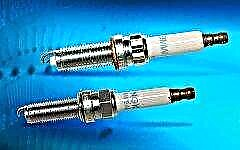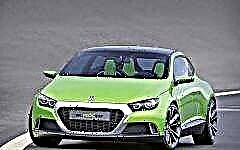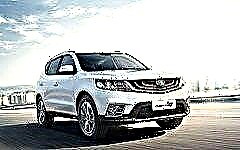

The content of the article:
- Bixenon as heir to xenon
- Advantages and Disadvantages of Bi-Xenon Lenses
- Choosing the right bixenon
Most motorists strive to organize their headlights as efficiently as possible in order to minimize the risk of accidents at night. Xenon lamps are considered the most popular, but bixenon with advanced functionality is also on sale.
Bixenon as heir to xenon

Bi-xenon headlights came into vogue at the end of the last century, simplifying the optical front design of cars. Bixenon is a type of xenon, characterized by the peculiarities of the operating mode. The fundamental difference is the presence of a mechanism that allows you to change the direction of light radiation.
Under the influence of a magnetic device, a metal curtain moves inside the headlight, allowing to slightly open various zones, operating in two modes - low and high beam, hence the prefix "bi" - "two" appeared in the name.
The standard D2S series bi-xenon lamp, mounted in conventional xenon lenses, has a beam of light directed onto an oval-shaped reflector. Due to this, the light is reflected from the reflector onto the lens and redistributed. A dynamic curtain can cover part of the light beam, creating a "low" light. When fully opened, the lens emits uniform light with clear boundaries and no side flare.
The principle of physical operation of xenon and bi-xenon devices is the same using a gas discharge lamp containing both the bulb itself and the inert gas filling it and the ignition side. The work is based on an inert gas, switching is carried out by a dynamic arc that changes its position.
Bixenon design may vary. Some devices move the shutter by moving the movable electrodes inside the bulb, while the other switches the light beam using an electromagnet that closes or opens the lamp surface.
When choosing a light source, it is necessary to study the design features of the headlights. Monoblock models contain all the light in a single housing. For separate headlights, the lamps for the high and low beam are installed separately.
Bi-xenon is especially well suited for cars with combined lighting modes, but for a separate mode, ordinary xenon is enough.
We emphasize that the devices are fundamentally different only by the focusing features. As for reliability, efficiency and brightness, the differences are almost subtle, and the characteristics of both types of headlights are unchanged.
Bixenon interacts with the design of the headlight, and for some cars switching to Bixenon from "native" standard light sources, the illumination may not change or even worsen. It depends on the increase in the wave frequency during intense scattering in xenon. The color temperature of the bixenon reaches 6,000 Kelvin, with an increase in the intensity of the scattering of the light beam and an increase in the frequency of the light wave.
Bi-xenon headlights have become an alternative to classic halogen lamps with a dual mode of light. When switching from halogen lamps, it is necessary to take into account the absence of lenses and an additional light beam diffuser.
HF Bi-Xenon may not be compatible with a headlamp designed for a halogen emitter. Therefore, for old cars, it is far from always advisable to install a bi-xenon, because first it is necessary to make design changes to the headlight itself with the installation of a collecting lens and additional polishing of the lens.
In any case, the independent installation of the bixenon is associated with numerous additions and alterations, followed by running around to legitimize the changes in the front light modification.
Advantages and Disadvantages of Bi-Xenon Lenses

The undoubted advantages are:
- versatility for low / high beam;
- high performance features.
For most parameters, xenon / bi-xenon headlights give out similar characteristics:
- The brightness level reaches about 3,200 lumens (twice as bright as halogen lamps), which provides better illumination of the road in the dark and increases traffic safety.
- The service life of the lamps is more than 3,000 hours (halogen lamps last half as much due to the presence of an incandescent filament).
- Low power consumption reduces generator load and reduces fuel consumption.
- Visibility in fog and poor conditions is improved by completely replacing fog lights in function.
- Does not give a blinding sharp beam to oncoming traffic (under conditions of professional regulation).
The disadvantages can be considered:
- Increased costs for the installation and purchase of bixenon, including the acquisition of the required ignition units, automatic control units, which together can amount to more than tens of thousands of rubles.
Bi-xenon lenses are not cheap. Therefore, in order to save money, some drivers prefer to stay on the old combination of xenon for low beam and halogen lamps for high beam.
- The complexity of self-assembly makes it necessary to constructively change the car with the subsequent legalization of lighting equipment, which is fraught with lengthy approvals with the traffic police and significant financial costs.
- Compatibility of bixenon (xenon) bases on specific car models. The headlamp must be marked "K". If one is not found, it is necessary to purchase zero block headlights.
- Incorrectly or improperly installed bi-xenon headlights lead to inevitable deprivation of rights, therefore, a certified auto center should deal with issues of legalization of optics.
- When buying a car with a bi-xenon on the secondary market, ask in advance whether they were installed normally or independently, and if the answer is the second, are there any permits for them.
- The cost of repairing a bixenon using original spare parts is extremely high, while xenon headlights only require the driver to change burnt-out lamps from time to time.
Choosing the right bixenon

Faced with the choice to improve the luminous performance of a vehicle, drivers pay attention to criteria regarding the performance and aesthetics of headlights.
The first condition for choosing a bi-xenon for a car is a meticulous study of the instructions and adherence to the recommendations given in them. The most important thing in the process of installing a bi-xenon light group is the accuracy of setting the switching of lighting modes, as a result of which the headlight begins to maintain the low and high beam modes.
Lenses
Lenses are standard or universal. Regular ones are produced under the brands Bosch, Hella, FX-R, Kotio and Valeo. Installation is only possible for D1S / D2S originals.
Bixenon universal type is equally suitable for both original devices and Chinese production. Mounted using a base / plinth suitable for H1 / H4 / H7 halogen models.
Plinth
The second qualifying point is the base corresponding to the car brand. The largest number of questions and problems are caused by universal lenses. Option H4 is suitable for Chinese bixenon. The H1 / H7 / HB3 / HB4 types work best with the Morimoto G5 lens.
Light parameters

The light characteristics after the completion of the installation work of the bi-xenon lenses in the optical head group of the car will certainly change. There is no definite answer as to which Bixenon is the best - it is a matter of taste preferences, which largely depend on the purpose of the installation. People who spend a lot of time on the road in a city with lighted roads choose beautiful and reliable ones.Those who often have to travel out of town with the included high beam, prefer lenses of long range and degree of brightness.
The most common bixenon has a pronounced specificity:
- G5. FX-R prototype. Provides the largest and widest light beam, perfect for driving on suburban highways. However, for those who like to drive at speeds exceeding 120 km / h, the brightness of the headlights may not be enough. Those drivers who have vision problems or regularly switch to high beams may not like the lenses. The illuminated zone starts at a distance of one and a half meters from the hood; for orientation purposes in the blind dark zone, it is recommended to use the usual illumination.
- G4. "Native" bixenon is produced under the Bosch brand. These lenses maximize illuminated area when driving in low beam and a clear, well-lit path when operating in long range.
- Q5. Koito prototype used in Audi Q5 models from 2010 onwards. The latest bixenon with the best performance, equally efficient in any light mode.
Price parameter
- The most budget-friendly and cost-effective reinstallation option is the Galaxy G5. The models are used in a variety of vehicles from different manufacturers, incl. domestic or having old standard xenon.
- "Golden mean" - Galaxy G4. The model is democratic in price and acceptable in quality. The only "drop of ointment in a barrel of honey" - installation is possible only under the H4 base.
- The undisputed sales leader is the Galaxy Q5, produced since 2014. It is the highest quality brand that has left competitors far behind. Compared to models from other manufacturers, the most expensive, at the same time the highest quality and most reliable. It has a long operating period, allowing a significant amount of time to use bixenon without replacement.
Design features of headlights
They must be taken into account when choosing a bi-xenon.
- The presence of corrugated optics - the beam of light from the bixenon will scatter, blinding the oncoming lane, which can cause an emergency. Such optics require either polishing or replacement with a transparent analog.
- The overall dimensions of the lenses should be slightly smaller than those of the optics in order to easily fit inside. It should be borne in mind that each car model has its own dimensions - you need to make measurements yourself or entrust it to specialists. If the headlamp is shallow, the large lens will not fit. Therefore, always pay attention to the dimensions of the lens and headlight, as well as their ratio.
The aesthetics of choice

In addition to excellent working qualities, many car owners want the bi-xenon to become a kind of decoration for the car. Therefore, pay attention to the appearance of the masks and their size range, although they are a purely decorative element.
The task of the mask is to cover the inside of the biomodule and hide the reflector, its function is to decorate the car.
It is possible to install hoods with "angel eyes", which add aesthetics and at the same time can act as daytime lights. Hoods range in size: 1.8 / 2.0 / 2.5 / 3.0 inches, and each has its own size mask.
The most popular light temperatures in bi-xenon lamps are:
- 4300K - yellow-white light, somewhat reminiscent of halogen glow, gives excellent visibility on wet asphalt and mud. It is standard for many car manufacturers;
- 5000K - pure white light, the brightest, but the road lighting is slightly inferior to the previous lamp.
There are also options for an amateur:
- 6000K - bluish light, outwardly more beautiful than the previous ones, but poorly illuminating the road;
- 8000K is a blue bright light that looks impressive, but does not illuminate the road from the word "at all".
Bixenon's "old age"
Bixenon of different “generations” is presented on the market at the same time, bearing the marking 1G / 3G / 5G. Each of them has its own characteristics, but in general they are all installed in the same way in the standard optics Н1 / Н4 / Н7 / НВ3-9005 / НВ4-9006 / НВ5-9007 without modification:
- 1st generation bixenon - 1G. The option is affordable and easy to maintain. Module dimensions: 12.5x8x5.5 cm, installation depth - not less than 12.5 cm. A distinctive feature is its small size, plastic was used in the production of the lens. The included lens in the form of dimensional plastic is surrounded by a bluish neon glow. The dipped beam is stepped. D2S plinth required.
- 3rd generation - 3G. The best option is "quality / price". The dimensions of the module are 12.5x8x7 cm. Using a larger lens gives brighter and softer light.
- 5th generation - 5G. Module dimensions: 13x8.6x6.9 cm. It is protected from external damage. The light switching relays are made in separate blocks associated with each lens.
- 2G / 4G options are considered unsuccessful.
Conclusion
The choice of bi-xenon lenses is individual and depends on the brand of the car, its optics and the owner's requests. Someone loves "brighter", someone "more economical", and someone strives for beauty, putting it at the forefront.











